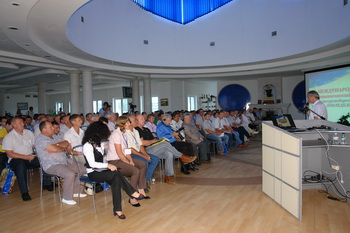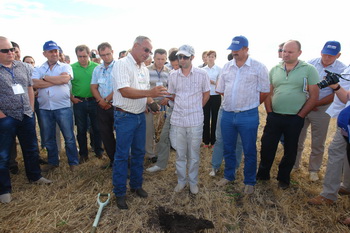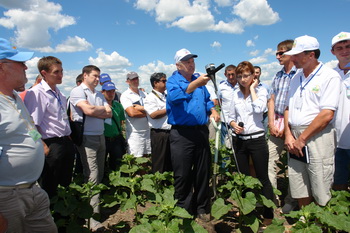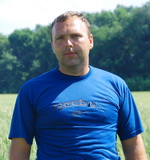| Mon | Tue | Wed | Thu | Fri | Sat | Sun |
| 1 | 2 | 3 | 4 | 5 | 6 | 7 |
| 8 | 9 | 10 | 11 | 12 | 13 | 14 |
| 15 | 16 | 17 | 18 | 19 | 20 | 21 |
| 22 | 23 | 24 | 25 | 26 | 27 | 28 |
| 29 | 30 | 1 | 2 | 3 | 4 | 5 |
On June 19-21, 2013 Model agricultural enterprise Agro-Soyuz hosted International practical Forum on sustainable agriculture based on systems approach No-Till. More than 100 farmers interested in modern agricultural technologies from Ukraine, Russia and Moldova took part in the event.
 This year the format of customary No-Till conference was changed. Vladimir Khorishko — the co-owner of Agro-Soyuz Holding — explained the reasons for that: ‘A conference is a training event; it provides knowledge, whereas a forum is an open and often a vivid dialogue, live communication, acceptance of existing problems and mutual search for solutions’.
This year the format of customary No-Till conference was changed. Vladimir Khorishko — the co-owner of Agro-Soyuz Holding — explained the reasons for that: ‘A conference is a training event; it provides knowledge, whereas a forum is an open and often a vivid dialogue, live communication, acceptance of existing problems and mutual search for solutions’.
«It’s been 10 years since Agro-Soyuz adopted No-Till technology. There are certain problems, but we’re still sure that conservation agriculture is the only way to work under existing economical and climatic conditions. The fact is that No-Till is not for weak people’, - adds Khorishko.
The No-Till experience of farmers from CIS countries is 10 years maximum. Unfortunately, farmers frequently fail when they try to adopt the technology due to the lack of knowledge about the details and elements of the systems. Our producers can «taste» No-Till during one year, become disappointed and return back to conventional tillage. However, only deep and comprehensive mastering of the technology, persistence in its adoption and extreme attention to details will make you successful.
This is confirmed by success stories of USA and Latin American farmers that have successfully been using zero-tillage for decades.
 During the Forum Rick Bieber, Rafiq Islam and Randall Reader (all — farmers from the USA) delivered their presentations.
During the Forum Rick Bieber, Rafiq Islam and Randall Reader (all — farmers from the USA) delivered their presentations.
Rick Bieber is a farmer from northern part of South Dakota, who’s been using No-Till technology for 21 years (he grows spring and winter wheat, corn, flax, peas, soybeans, safflower and alfalfa). Rick is the President of South Dakota Association of No-Till farmers.
During his presentation Rick mentioned the major role of crop rotations and cover crops in No-Till system. He doesn’t question the efficiency of zero-tillage, since he sees the result on his land. Due to cover crops and retention of crop residues the soil is restored, the need in herbicides and fungicides diminishes, while the yields are growing. For example, Rick’s corn yields average 8.2 t/ha, while his neighbors that implement conventional tillage can produce only 3-4 t/ha. ‘If we do not care for our soils, they will stop feeding us. We cannot afford intensive soil tillage’ — says Rick Bieber.
 The topic of cover crops was further developed by other speakers. Rafiq Islam — Director of the Soil, Water and Bioenergy Resources Program at the Ohio State University years of research experience as a soil scientist on field experimentation with diverse cover crops especially cover crop cocktail mix under different tillage operations and crop rotation.
The topic of cover crops was further developed by other speakers. Rafiq Islam — Director of the Soil, Water and Bioenergy Resources Program at the Ohio State University years of research experience as a soil scientist on field experimentation with diverse cover crops especially cover crop cocktail mix under different tillage operations and crop rotation.
Rafiq suggested that cover crop cocktails work as a biological stimulator improving efficiency of solar energy use; they also enrich the soil with different organic residues and improve No-Till performance, making the ecosystem stronger.
 Randall Reader (Associate Professor and Extension Agricultural Engineer (P.E.) at the Ohio State University) made a presentation on soil compaction issues. ‘The best way to tackle compaction is continuous No-Till,’ — assured the speaker.
Randall Reader (Associate Professor and Extension Agricultural Engineer (P.E.) at the Ohio State University) made a presentation on soil compaction issues. ‘The best way to tackle compaction is continuous No-Till,’ — assured the speaker.
The specialists of Agro-Soyuz (Edward Romankov, Elena Dudkina and Natalia Skorobogataya) also shared their experience on production of high crop yields under dryland conditions, crop nutrition and economics of No-Till.
During the Forum plenty of time was devoted to practical issues, because this is the way to answer many of farmers’ questions. Half of the time was allocated for field work, where speakers demonstrated to participants how to measure soil density, soil quality and explained different options of cover crop mixtures.
Farmers appreciated presentations of their peers that have been using No-Till for several years — Mikhail Draganchuk, Alexandr Makarkov and Alain Renar. The round table discussion called «The issues of No-Till adoption and implementation» was really vivid.
The participants of the Forum speak about themselves and share their impressions about the event.
 Levashko Alexey, Senior Agronomist of Donskoye LLC (RZ-Agro Holding), Rostov region, Russia:
Levashko Alexey, Senior Agronomist of Donskoye LLC (RZ-Agro Holding), Rostov region, Russia:
— We implement mini-till on our farm (21500 ha of crop land). We do not plow; only for sunflowers we use deep ripping. For other crops we only use disc harrows. We produce winter wheat (50% of our land), peas, spring barley and sunflowers. Recently, we’ve introduced a green fallow (we sow sainfoin) in order to eliminate black fallow. We want to improve soil structure and save some money on fertilizers due to cover crops.
We stopped plowing about 5-6 years ago. Erratic precipitation and lack of moisture make us consider zero-tillage. Droughts result in high yield losses. In this situation one has to think about more efficient water use.
It is our second time at Agro-Soyuz. Our first time was in 2011 when we attended the Crop production school, which we liked very much. Today, we attend the No-Till Forum, because we want to try zero-tillage on small area. We understand that we’ll have to re-consider our crop rotation in order to increase the amount of crop residues. Here we’re interested in practical advice and details, e.g. seeding rates, herbicides application rates and costs, everything related to cover crops and establishment of crop rotations.
 Alexandr Mizin, Senior Agronomist of «Kolos» farm, Poltava region, Ukraine:
Alexandr Mizin, Senior Agronomist of «Kolos» farm, Poltava region, Ukraine:
— Our farm has 3000 hectares of land. We implement mini-till, partially No-Till. Now we decided to convert to full No-Till. The reason is that we want to use our scarce soil moisture more efficiently. We do not have enough precipitation, e.g. we received only 30 mm from April 1. And we see how tillage affects crop emergence, e.g. No-Till wheat emerged all right, whereas after discing we were waiting for 3 weeks before our wheat emerged.
All the topics are interesting for us here. It is very beneficial to listen to your peers that implement zero-tillage for several years. I think, their experience will be very useful for us.